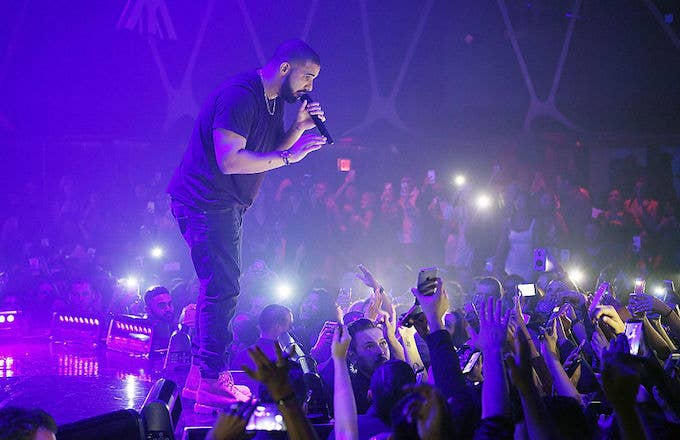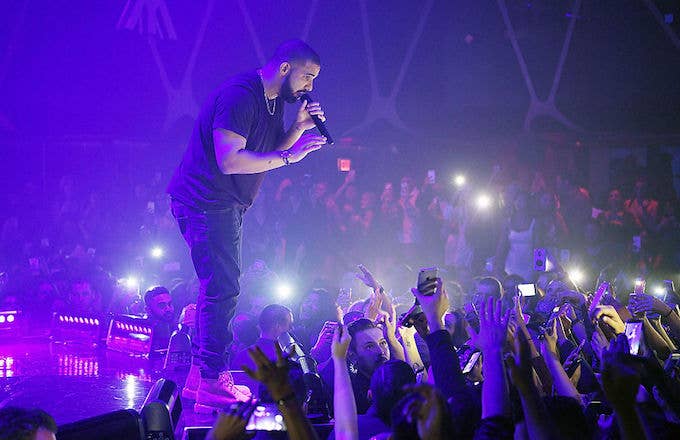
This week’s Billboard Hot 100 has a familiar name at the top, though with an unfamiliar sound. Drake’s new single “Nice for What” made it to number one. The track has gained attention for many reasons, beyond its looped Lauryn Hill sample and star-studded video. The song screams New Orleans—and, more specifically, bounce.
Bounce is a New Orleans-created style of hip-hop that began in the early 1990s. Its hallmarks are often-raunchy call-and-response chants, shout-outs to the city’s neighborhoods and housing projects, and a couple of key samples—"Triggaman" and “Brown Beats.”
Drake, as always, took pains to get the style right. “Nice for What” features bounce artists Big Freedia and 5th Ward Weebie, and N.O. producer BlaqNmilD, who has worked with tons of bounce artists, including the genre’s inventors.
Matt Miller, author of the 2012 bookBounce: Rap Music and Local Identity in New Orleans, filled me in on the history of pop music borrowing from the Big Easy.
“The Drake song is just one of many instances of elements from bounce being appropriated by artists from other places,” he writes in an email. “The list stretches from 2 Live Crew in the early 1990s, to like-minded independent artists in places like Memphis and Atlanta such as FM and N.P.C., to more recent examples of influence and appropriation by artists including Beyoncé and Miley Cyrus… With its dynamic cultural mixture and a variety of vibrant, street-level musical expressions and traditions at the grassroots, it only stands to reason that New Orleans would be a source of innovative musical ideas.”
When I talked to the rapper and producer Devious, who helped write, arrange, and produce one of bounce’s very first songs, DJ Jimi’s “Where They At,” he was happy that one of music’s biggest stars had used a sound he played a large part in inventing.
“I feel that it is a great song,” he said about “Nice for What.” “It’s almost like I was one of the first, and now it’s resurfacing with all national artists.”
Drake taking it, anyone taking it, is our Grammy.
Of course, as Matt Miller pointed out, this is not the first time that a bounce-inspired song has been a hit. Many people mentioned Beyoncé’s “Get My Bodied” and T.I. and Lil Wayne’s “Ball” as predecessors.
DJ Mellow Fellow, who worked on “Where They At” alongside Devious, took note of the trend and said that adding bounce elements to a song is “like the formula for making hits.”
“It’s like we just utilize it and the world benefits, too,” he said.
To producer and rapper Ice Mike, whose early work both on the mic and behind the boards was crucial to the style, adding bounce flavor to a song is an obvious thing to do. “Any time you add bounce elements—not just bounce elements, but New Orleans elements period—it’s seems like those songs are the long lasting super big hits,” he explained.
Precise, another major “Where They At” contributor who also discovered Juvenile and Mystikal and produced seminal bounce tracks by Black Menace and Partners N’ Crime—and who occasionally gives lectures at Xavier University about bounce music—says that he and his peers appreciate the recognition.
“Every three to four years you have this run of New Orleans culture,” he said when I caught up with him over the phone. “It helps our spirit to know that we are being recognized, because we’re not going to win no awards for this shit. Drake taking it, anyone taking it, is our Grammy.”
That sense of gratitude was shared by many of the people that I talked to.
“It kind of gave me a warm fuzzy,” DJ Nonstop laughed when I asked how he felt about Drake’s new hit. Nonstop was the producer of Everlasting Hitman’s “Bounce! Baby, Bounce!”, the song that gave bounce its name. “We started this back in ’92, and here it is 2018 and the world is just now catching up to it. It’s like wow, we did that. It felt like we won as a team.”
That sense of being a team is long-running. New Orleans is both geographically and culturally distant from the coastal centers of the music business, so the people creating a new sound in the early ’90s had to write and produce their own music, and start their own labels like Big Boy and Cash Money to get it out into the world. Even when bounce made it to the ears of executives, it would often be dismissed as a “local” phenomenon.
While a poppier, more melodic version of the sound made it to mainstream prominence starting in the late 1990s, thanks to Mannie Fresh and Cash Money, the original vision of the sound continued to mostly be a New Orleans phenomenon until the exodus caused by Katrina helped it spread.
“A lot of bounce music has trickled across the U.S. quietly,” Nonstop explained to me. “It’s been trickling for years, and with the spread of people from New Orleans after the Katrina incident, that really opened the door for the bounce music to fly in other places, because everybody wanted a taste of home.”
Many of the people who started the style expressed hope that bounce’s current turn in the spotlight would bring more attention to artists in New Orleans itself. Mr. Meana of Partners N’ Crime, whose song “Pump the Party” helped set off the bounce revolution, told me that he thought “Nice for What” could bring the style to a wider audience.
“It can expose our culture, meaning there’s other artists that can piggyback off of this and get heard in the proper light now because people are open to the sound,” he said. “Now that they heard it from Cardi B [who sampled DJ Jimi’s “Bitches (Reply)” on “Bickenhead”], now that they heard it from Drake, they [realize] this is a New Orleans sound. Maybe artists from New Orleans can come with the sound and fill in with the original way that we do it.”
Mr. Meana’s PNC groupmate Kango Slimm had similar hopes.
“I hope that it opens a lot of the music community’s eyes to what’s going on down here and helps them to realize that we do have a market down here,” he elaborated. “We have a certain sound down here in New Orleans that can be shown to the world. We’ve been doing it for so long and the world hasn’t been accepting it as much as they accept it from someone like Drake, Beyoncé, or Cardi B.”
Lil Ya of the group UNLV, one of the creators of a more street-ready bounce hybrid sometimes known as “gangsta bounce” that would take over the world in the late 1990s with the success of the Hot Boys (he's working on a biopic about his influential group called Uptown 4 Life) , summed up the feelings of much of his generation about the fact that their creation is back on the charts.
“Coming from the beginning of the bounce era, it came a long way and I’m proud of it,” he said. “I’m proud to be one of the pioneers.”

